Deformation Patterns and Control of Existing Tunnels Induced by Coastal Foundation Pit Excavation
Abstract
1. Introduction
2. Materials and Methods
2.1. Project Overview
2.2. Test Method and Procedure
2.2.1. Statistical Evaluation of Tunnel Deformation Impacts
2.2.2. Numerical Simulation and Computation
2.2.3. Field Measurement Study
3. Results
3.1. Results of the Statistical Evaluation of Tunnel Deformation Impacts
3.2. Analysis of Numerical Simulation Results
3.2.1. Numerical Simulation Results of Field Working Conditions
3.2.2. Influence of Horizontal Clear Distance Between Foundation Pit and Tunnel
3.2.3. Influence of Tunnel Burial Depth
3.2.4. Influence of Diaphragm Wall Thickness
3.2.5. Influence of Retaining Structure Embedment Ratio
3.3. Analysis of Field Measurement Data
3.3.1. Vertical Displacement Analysis of Shield Tunnel
3.3.2. Shield Tunnel Horizontal Displacement Analysis
4. Discussion
4.1. Analysis of Tunnel Deformation
4.2. Sensitivity Analysis of Key Factors
5. Conclusions
- (1)
- Analysis of 30 excavation cases near existing tunnels in different soft strata indicates that tunnels in silt strata exhibit deformation magnitudes below 10 mm with higher frequency compared to those in silty clay strata, suggesting greater susceptibility of tunnels in silty clay to adjacent excavations. Considering regional geological variations and influential factors including relative positioning, separation distance, and burial depth between excavations and existing tunnels, comprehensive sensitivity analysis incorporating multiple parameters is recommended.
- (2)
- With increasing excavation depth, both bending moments and displacements of adjacent tunnels progressively intensify. During initial excavation stages, tunnel deformations remain relatively minor. Upon completion of excavation, lateral bending moments increase while vertical bending moments decrease, forming a horizontal oval bending moment distribution pattern. The tunnel demonstrates a global tendency to displace towards the excavation zone.
- (3)
- Monitoring data confirm that excavation-induced stress relief drives deep soil movement towards the pit, consequently displacing shield tunnels in the same direction. Both vertical and horizontal tunnel displacements progressively accumulate during excavation, exhibiting magnitude–distance correlation. Maximum tunnel settlement (3.85 mm) occurs at Ring 530 nearest to excavation, with the affected zone extending approximately 114 m. Maximum horizontal displacement approaches 5 mm, satisfying relevant code requirements. These findings provide scientific references for deformation control in existing tunnels within coastal silty clay strata.
- (4)
- Sensitivity analysis of tunnel deformation in coastal silty clay. Within the same stratum, the horizontal clear distance between the excavation pit and the tunnel exerts significant influence on tunnel deformation. When the excavation is completed, the deformation of tunnels spaced 10 m apart increases by one-third compared to those spaced 25 m apart. The displacement vectors of the tunnel rotate counterclockwise from the upper left, with the maximum displacement gradually approaching the left haunch of the tunnel arch. Furthermore, tunnel burial depth also demonstrates notable impacts on displacement—shallower tunnels experience more severe deformation and greater displacement under excavation effects. However, under stable excavation conditions, modifying diaphragm wall thickness and the embedment ratio of pit retaining structures show limited effectiveness in controlling adjacent tunnel deformation. Additional measures targeting the tunnel side are required for effective deformation control. Field measurements are also necessary to further validate the sensitivity factors affecting tunnel deformation in coastal silty clay environments.
Author Contributions
Funding
Data Availability Statement
Acknowledgments
Conflicts of Interest
References
- Tian, P.; Wang, Z.; Li, J.; Cao, L.; Liu, Y.; Zhang, H.; Ai, S. Spatiotemporal characteristics and driving mechanism of high-intensity development of continental coastal zones in the East China Sea. Geogr. Res. 2023, 42, 156–171. [Google Scholar]
- Chen, X.; Li, K.; Bao, X.; Hong, C.; Fu, Y.; Cui, H. Innovations in the development of digital and intelligent Construction of urban shield tunnels. J. Basic Sci. Eng. 2021, 29, 1057–1074. [Google Scholar] [CrossRef]
- Su, D.; Huang, M.; Han, W.; Li, A.; Wang, E.; Chen, X. Suitability evaluation of underground space development in Shenzhen: Urban geoenvironmental considerations. Earth Sci. Front. 2023, 30, 514–524. [Google Scholar] [CrossRef]
- Wang, C.; Liu, L. Analysis on the future development trend of urban rail transit in China. Urban Rail Transit 2019, 22, 22–24. [Google Scholar] [CrossRef]
- Xu, X.; Deng, Y.; Zhou, L.; Ming, W.; Zhang, H.; Xia, C. Experimental study on temperature effect of consolidation and permeability of coastal soft soil. J. Eng. Geol. 2023, 2023, 1–8. [Google Scholar] [CrossRef]
- Liu, B.; Yu, Z.; Han, Y.; Wang, Z.; Zhang, R.; Wang, S. Analytical solution for the response of an existing tunnel induced by above-crossing shield tunneling. Comput. Geotech. 2020, 124, 103624. [Google Scholar] [CrossRef]
- Zhang, Z.G.; Huang, M.S.; Wang, W.D. Evaluation of deformation response for adjacent tunnels due to soil unloading in excavation engineering. Tunn. Undergr. Space Technol. 2013, 38, 244–253. [Google Scholar] [CrossRef]
- Liang, R.; Wu, W.; Yu, F.; Jiang, G.; Liu, J. Simplified method for evaluating shield tunnel deformation due to adjacent excavation. Tunn. Undergr. Space Technol. 2018, 71, 94–105. [Google Scholar] [CrossRef]
- Fu, Y.; Wang, B.; Wu, H.; Chen, X.; Sun, X.; Bian, Y.; Shen, X. Theoretical analysis on horizontal rectification of tunnel near deep foundation pit by grouting. Tunn. Undergr. Space Technol. 2023, 133, 104977. [Google Scholar] [CrossRef]
- Huang, X.; Schweiger, H.F.; Huang, H. Influence of Deep Excavations on Nearby Existing Tunnels. Int. J. Geomech. 2013, 13, 170–180. [Google Scholar] [CrossRef]
- Sun, H.; Chen, Y.; Zhang, J.; Kuang, T. Analytical investigation of tunnel deformation caused by circular foundation pit excavation. Comput. Geotech. 2019, 106, 193–198. [Google Scholar] [CrossRef]
- Bian, X.; Hu, H.; Zhao, C.; Ye, J.; Chen, Y. Protective effect of partition excavations of a large-deep foundation pit on adjacent tunnels in soft soils: A case study. Bull. Eng. Geol. Environ. 2021, 80, 5693–5707. [Google Scholar] [CrossRef]
- Wei, G.; Feng, F.; Cui, Y.; Wang, X.; Diao, H.; Wu, Y. Research on the influence of foundation pit excavation on the lateral force and deformation of side shield tunnels based on full-scale experiments. Tunn. Undergr. Space Technol. 2023, 140, 105236. [Google Scholar] [CrossRef]
- Masayasu, H.; Shiro, O.; Tatsuaki, K.; Ohmae, Y. Effects of the ring-cut excavation method on ground displacements and stability of a tunnel face. J. Tunn. Eng. 2017, 17, 1–8. [Google Scholar]
- Yu, Z.T.; Wang, H.Y.; Wang, W.; Ling, D.S.; Zhang, X.D.; Wang, C.; Qu, Y.H. Experimental and Numerical Investigation on the Effects of Foundation Pit Excavation on Adjacent Tunnels in Soft Soil. Math. Probl. Eng. 2021, 2021, 5587857. [Google Scholar] [CrossRef]
- Li, M.; Chen, J.; Wang, J.; Zhu, Y. Comparative study of construction methods for deep excavations above shield tunnels. Tunn. Undergr. Space Technol. 2018, 71, 329–339. [Google Scholar] [CrossRef]
- Shi, J.; Ng, C.W.W.; Chen, Y. Three-dimensional numerical parametric study of the influence of basement excavation on existing tunnel. Comput. Geotech. 2015, 63, 146–158. [Google Scholar] [CrossRef]
- Shi, J.; Ng, C.W.W.; Chen, Y. A simplified method to estimate three-dimensional tunnel responses to basement excavation. Tunn. Undergr. Space Technol. 2017, 62, 53–63. [Google Scholar] [CrossRef]
- Zhang, D.; Xie, X.; Li, Z.; Zhang, J. Simplified analysis method for predicting the influence of deep excavation on existing tunnels. Comput. Geotech. 2020, 121, 103477. [Google Scholar] [CrossRef]
- Li, D.; Liao, F.; Wang, L.; Lin, J.; Wang, J. Multi-Stage and Multi-Parameter Influence Analysis of Deep Foundation Pit Excavation on Surrounding Environment. Buildings 2024, 14, 297. [Google Scholar] [CrossRef]
- Zhuang, Y.; Cui, X.; Hu, S. Numerical simulation and simplified analytical method to evaluate the displacement of adjacent tunnels caused by excavation. Tunn. Undergr. Space Technol. 2023, 132, 104879. [Google Scholar] [CrossRef]
- He, C.; Cai, Y.; Pu, C.; Zhou, S.; Di, H.; Zhang, X. Deformation analysis and protection measures of existing metro tunnels effected by river channel excavation in soft soils. Tunn. Undergr. Space Technol. 2024, 144, 105504. [Google Scholar] [CrossRef]
- Zhang, J.; Xie, R.; Zhang, H. Mechanical response analysis of the buried pipeline due to adjacent foundation pit excavation. Tunn. Undergr. Space Technol. 2018, 78, 135–145. [Google Scholar] [CrossRef]
- Zhao, Y.; Chen, X.; Hu, B.; Wang, P.; Li, W. Evolution of tunnel uplift induced by adjacent long and collinear excavation and an effective protective measure. Tunn. Undergr. Space Technol. 2023, 131, 104846. [Google Scholar] [CrossRef]
- Zhang, X.; Wei, G.; Lin, X.; Xia, C.; Wei, X. Transverse Force Analysis of Adjacent Shield Tunnel Caused by Foundation Pit Excavation Considering Deformation of Retaining Structures. Symmetry 2021, 13, 1478. [Google Scholar] [CrossRef]
- Niu, Y.; Wang, Q.; Ma, F. Study on the Influence of Foundation Pit Excavation on the Deformation of Adjacent Subway Tunnel in the Affected Area of Fault Zones. Sustainability 2023, 15, 9462. [Google Scholar] [CrossRef]
- Zhang, S.; Li, X. Numerical analysis of deep foundation pit zoned excavation. Low Temp. Archit. Technol. 2012, 2012, 113–115. [Google Scholar]
- Chen, J.J.; Wang, J.H.; Xiang, G.W.; Wen, S.L.; Du, Y. Numerical study on the movement of existing tunnel due to deep excavation in Shanghai. Geotech. Eng. J. SEAGS AGSSEA 2011, 42, 30–40. [Google Scholar]
- Chen, J.; Liu, W.; Sun, X. Effects of Tuned Rail Damper on Track Dynamic Characteristics Optimization. Procedia Eng. 2017, 199, 1616–1622. [Google Scholar] [CrossRef]
- Ruan, H.T.; Zhao, J.H.; Huang, W.D.; Liu, L. Design and analysis of concurrent excavation of adjacent deep foundation pits. Chin. J. Geotech. Eng. 2010, 32, 146–150. [Google Scholar]
- Wei, G. Measurement and analysis of impact of foundation pit excavation on below existed shield tunnels. Rock Soil Mech. 2013, 34, 1421–1428. [Google Scholar] [CrossRef]
- Jian, R.; Huang, R.; Xu, C.X. Influence of deep excavation on the adjacent existing shielded tunnel in Hangzhou area. Soil Eng. Found. 2023, 37, 982–986. [Google Scholar]




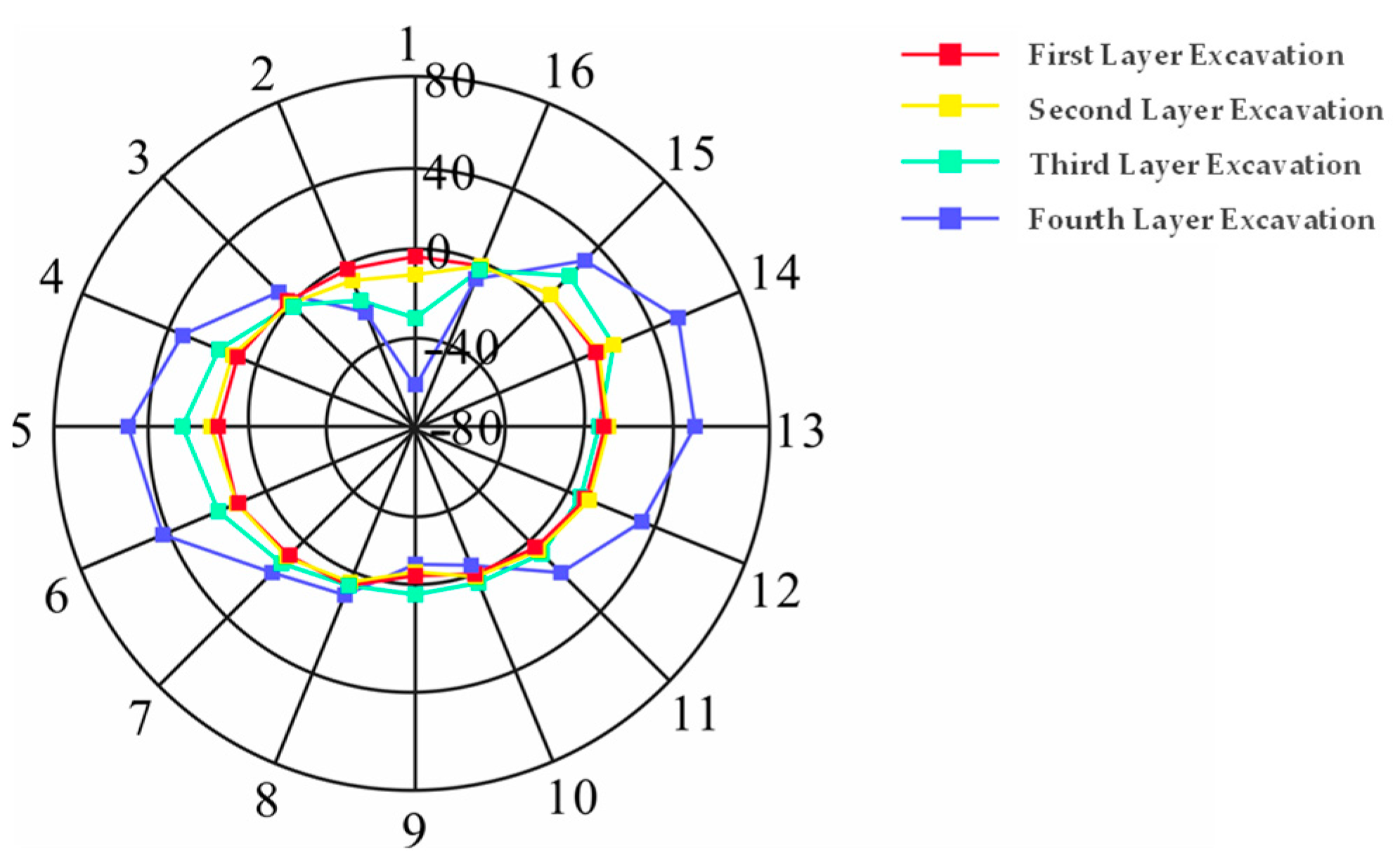
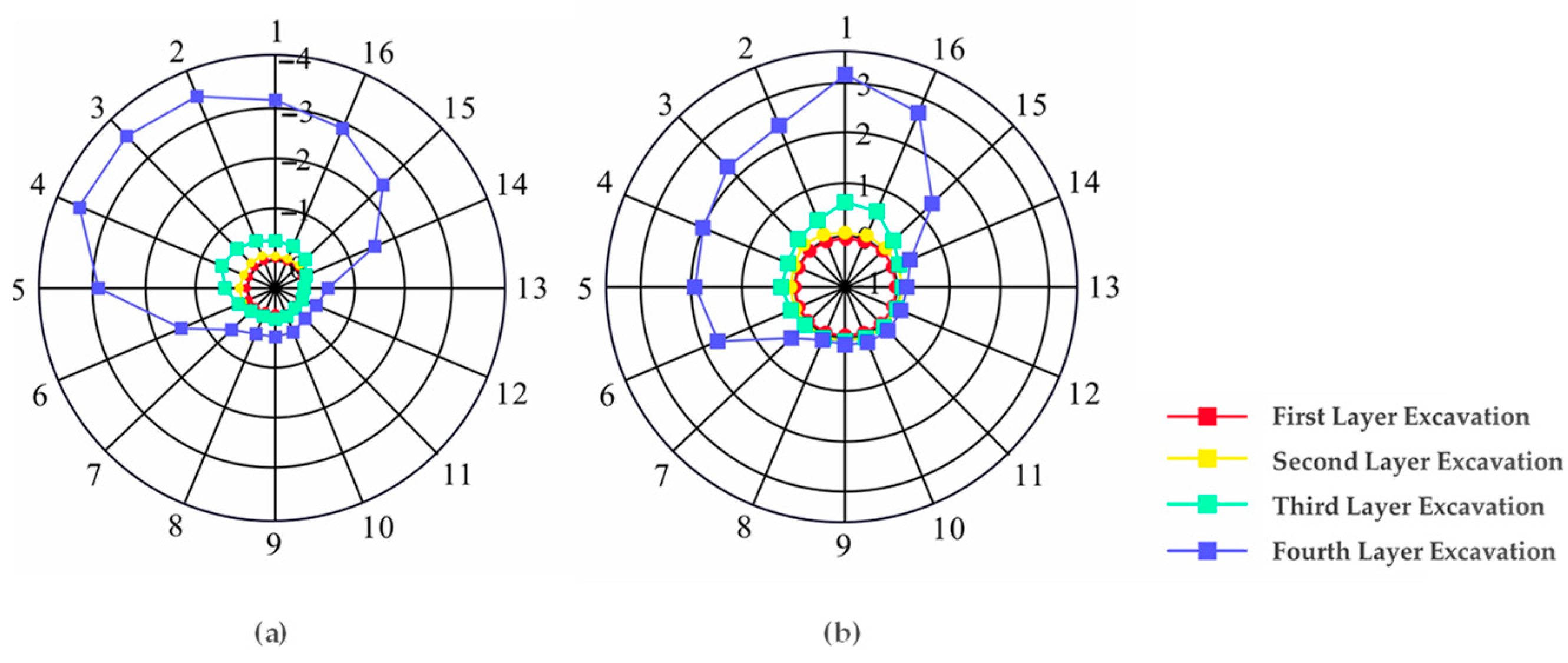
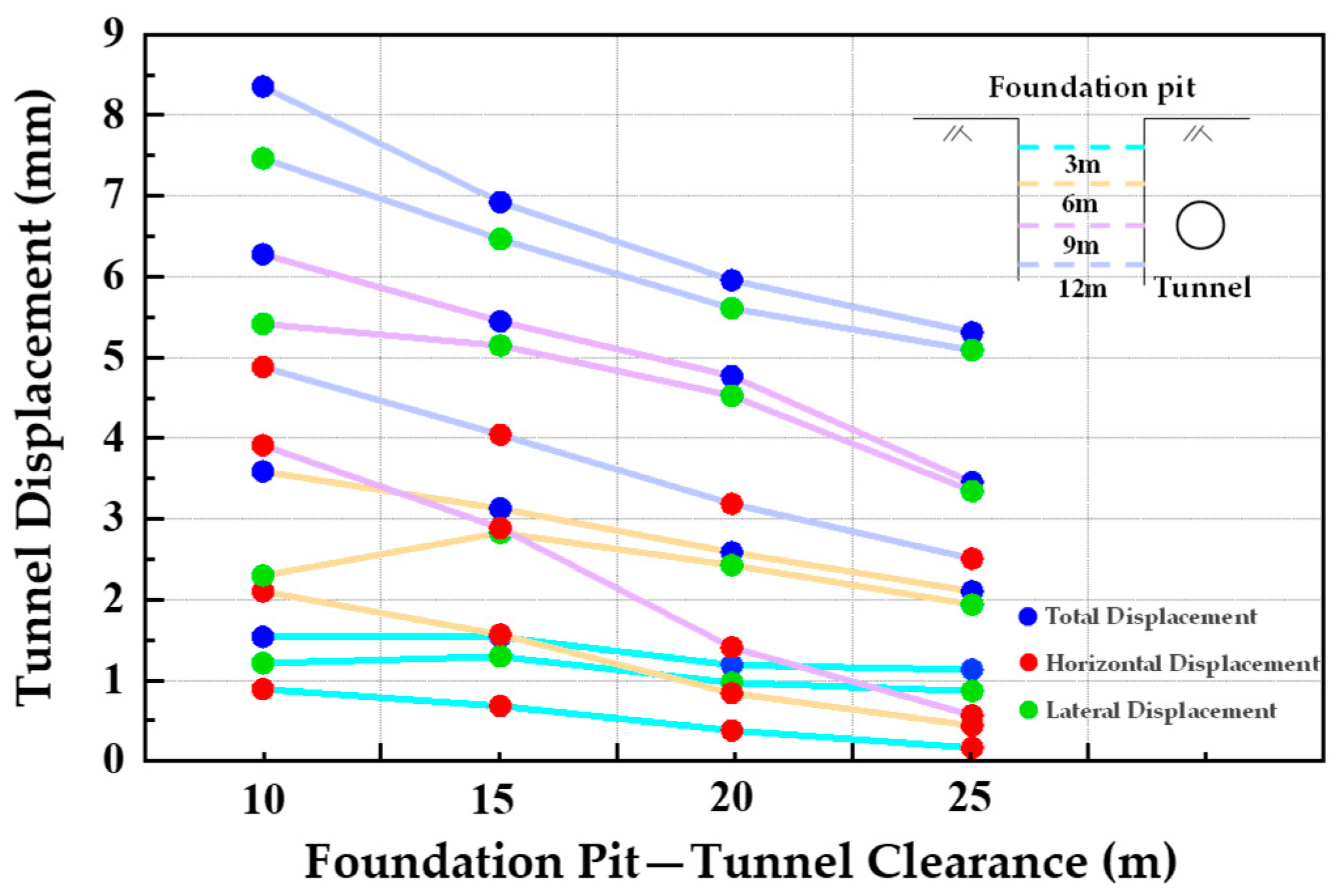
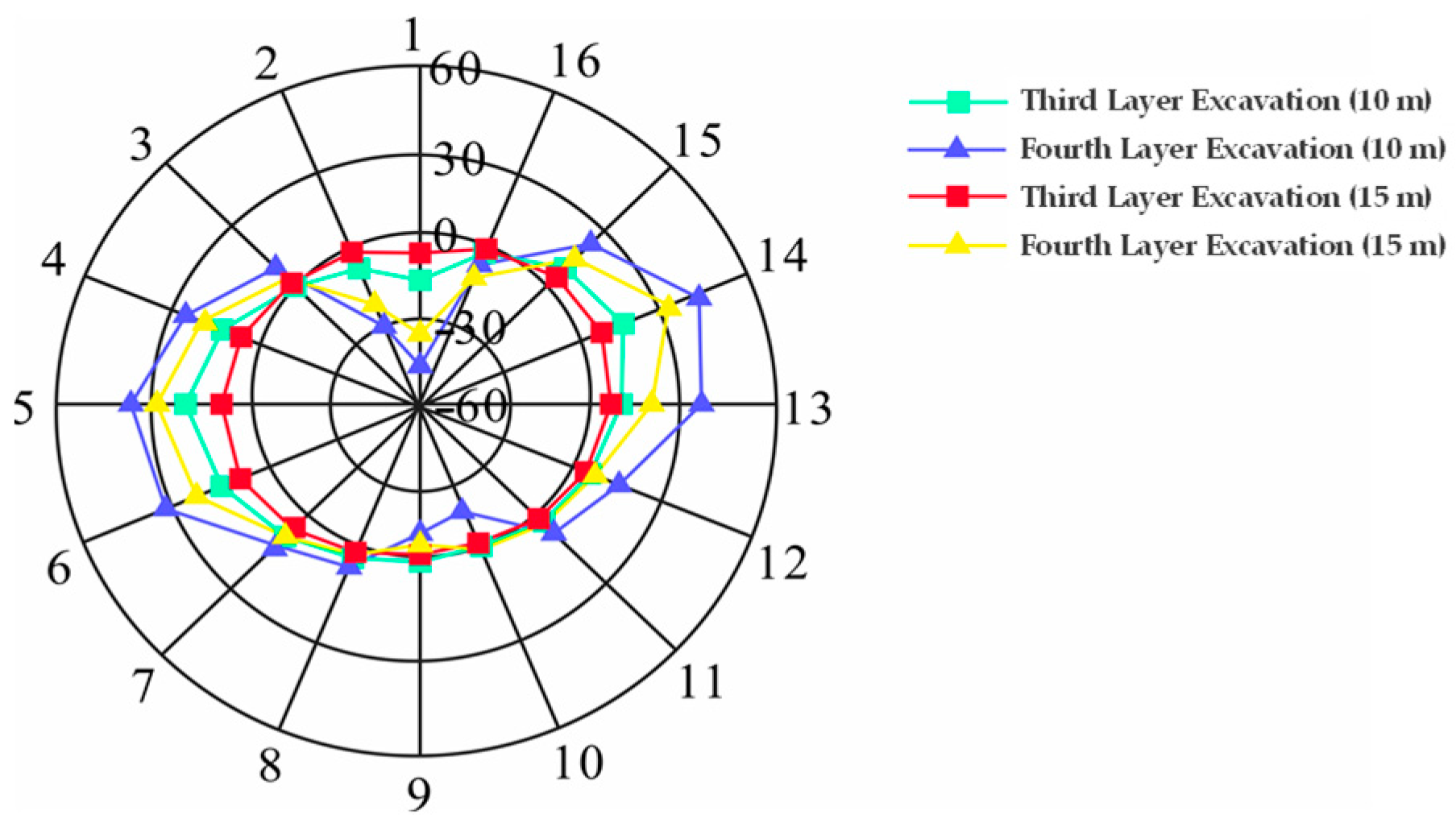

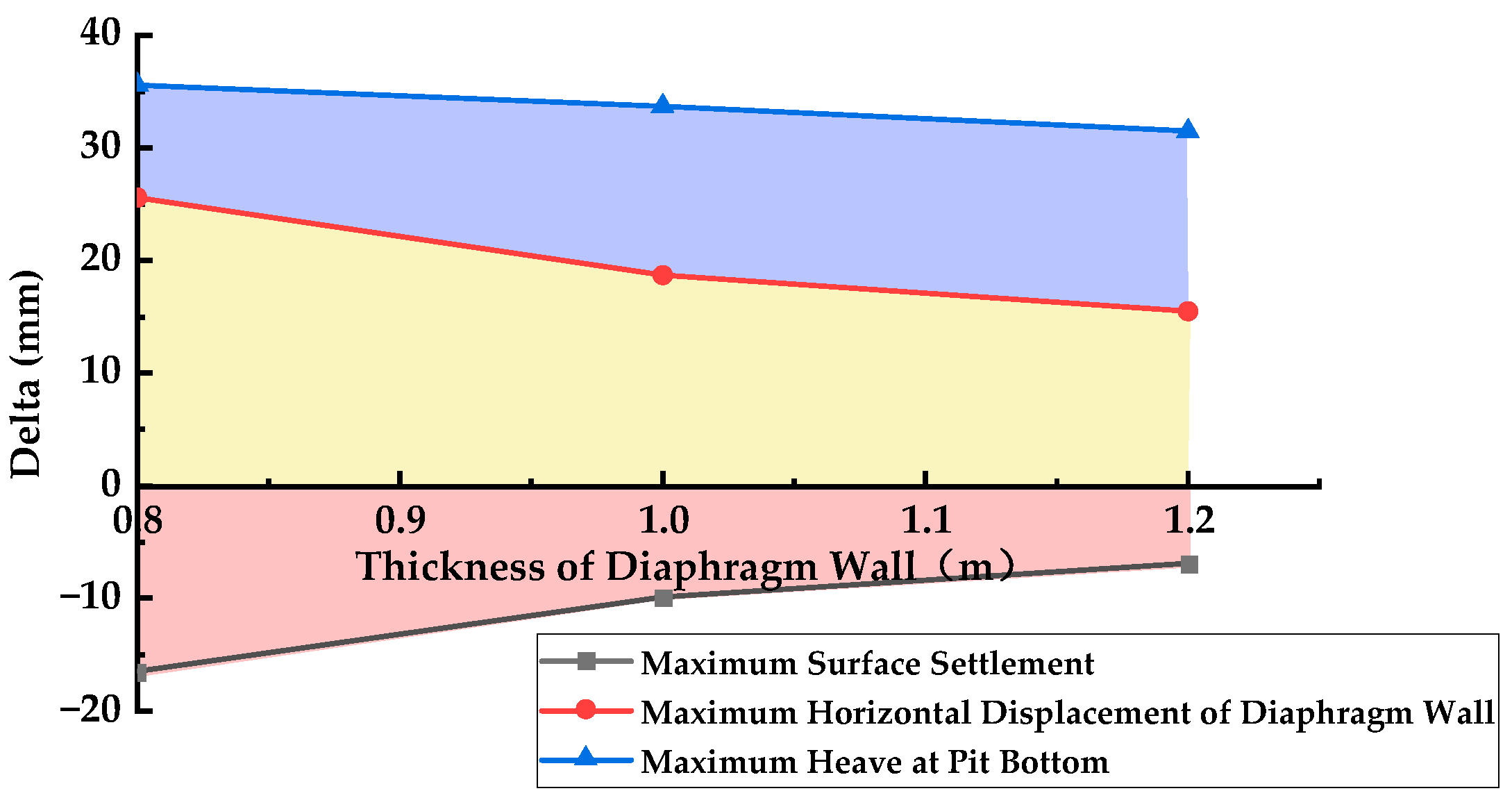
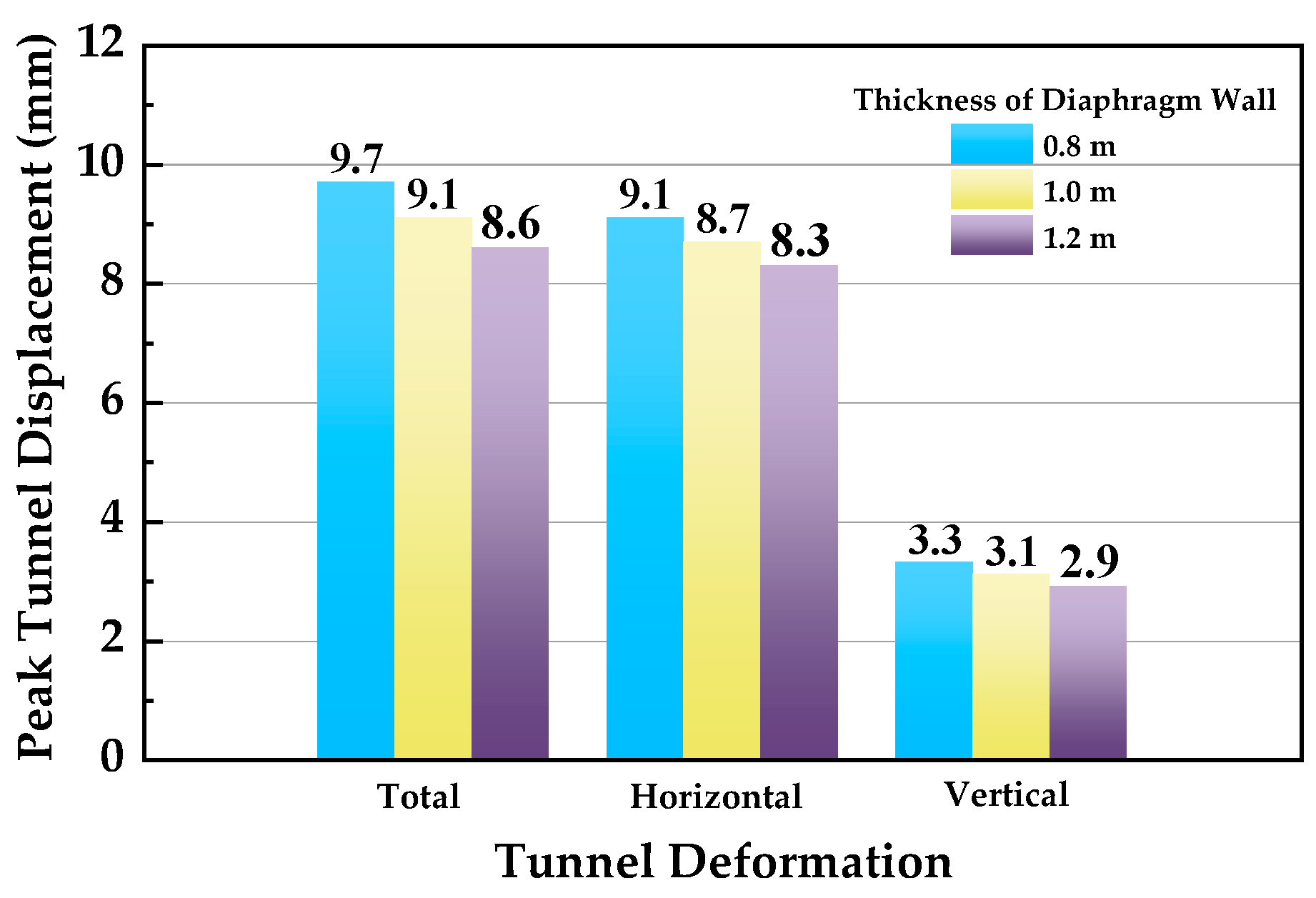
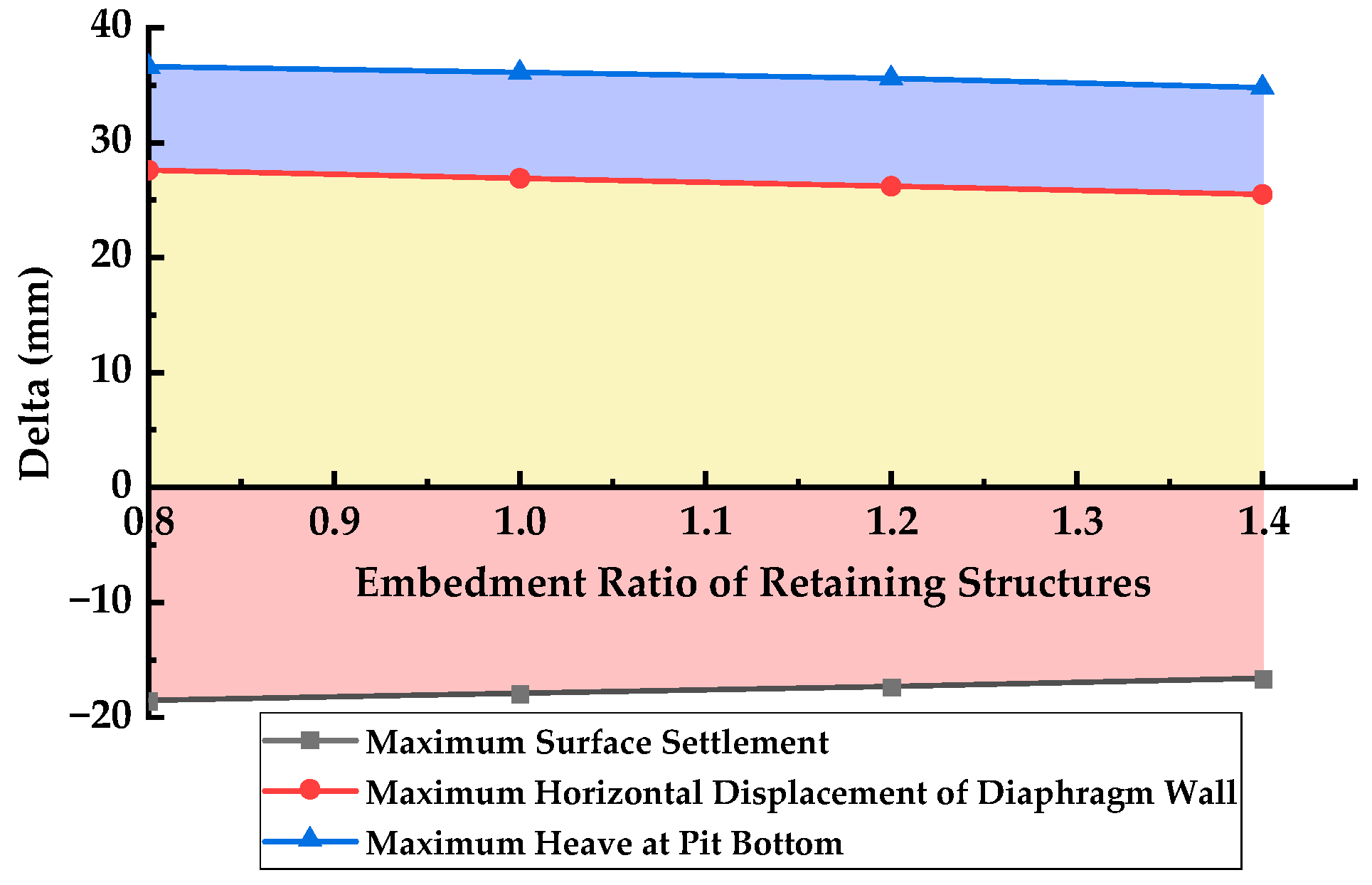
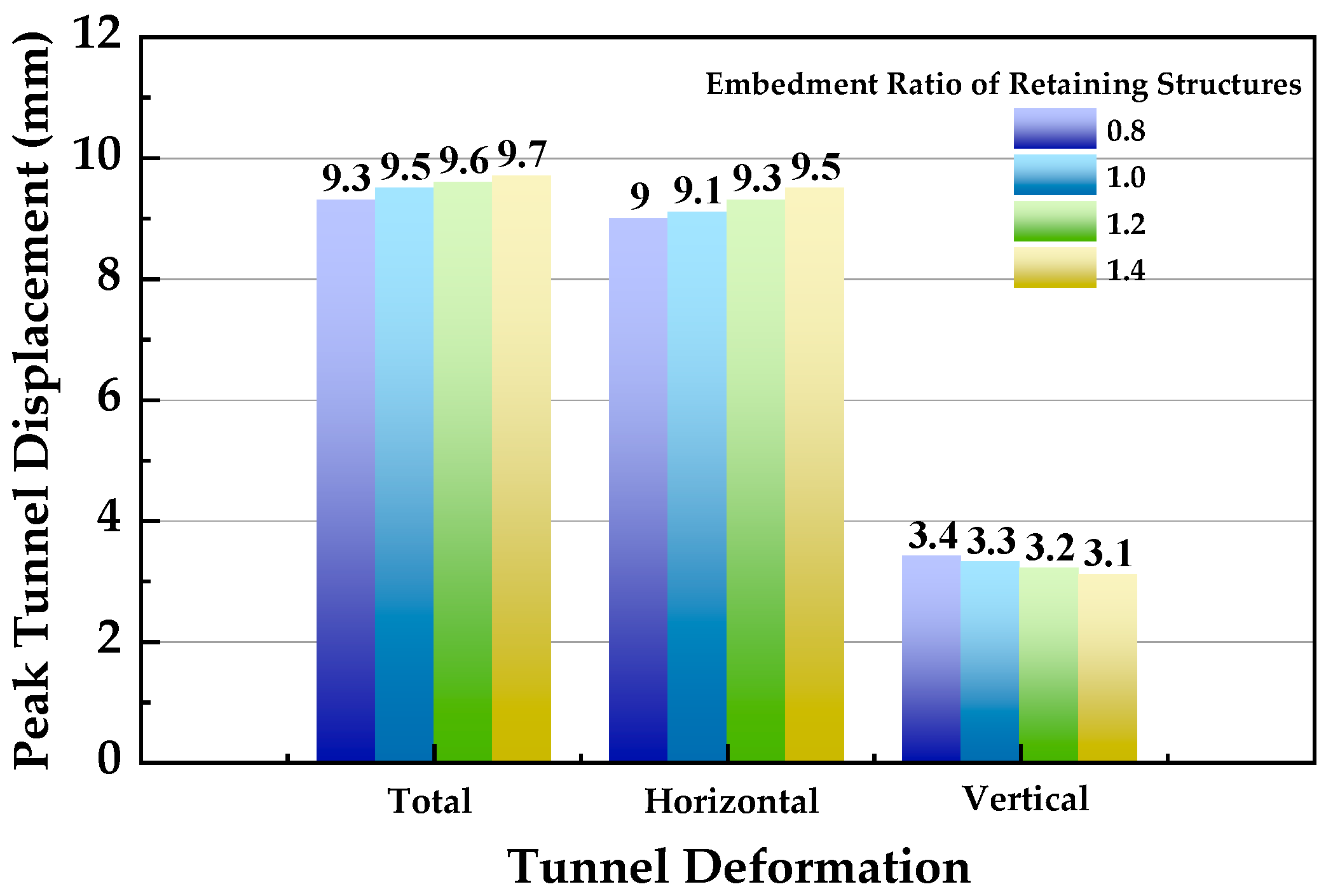
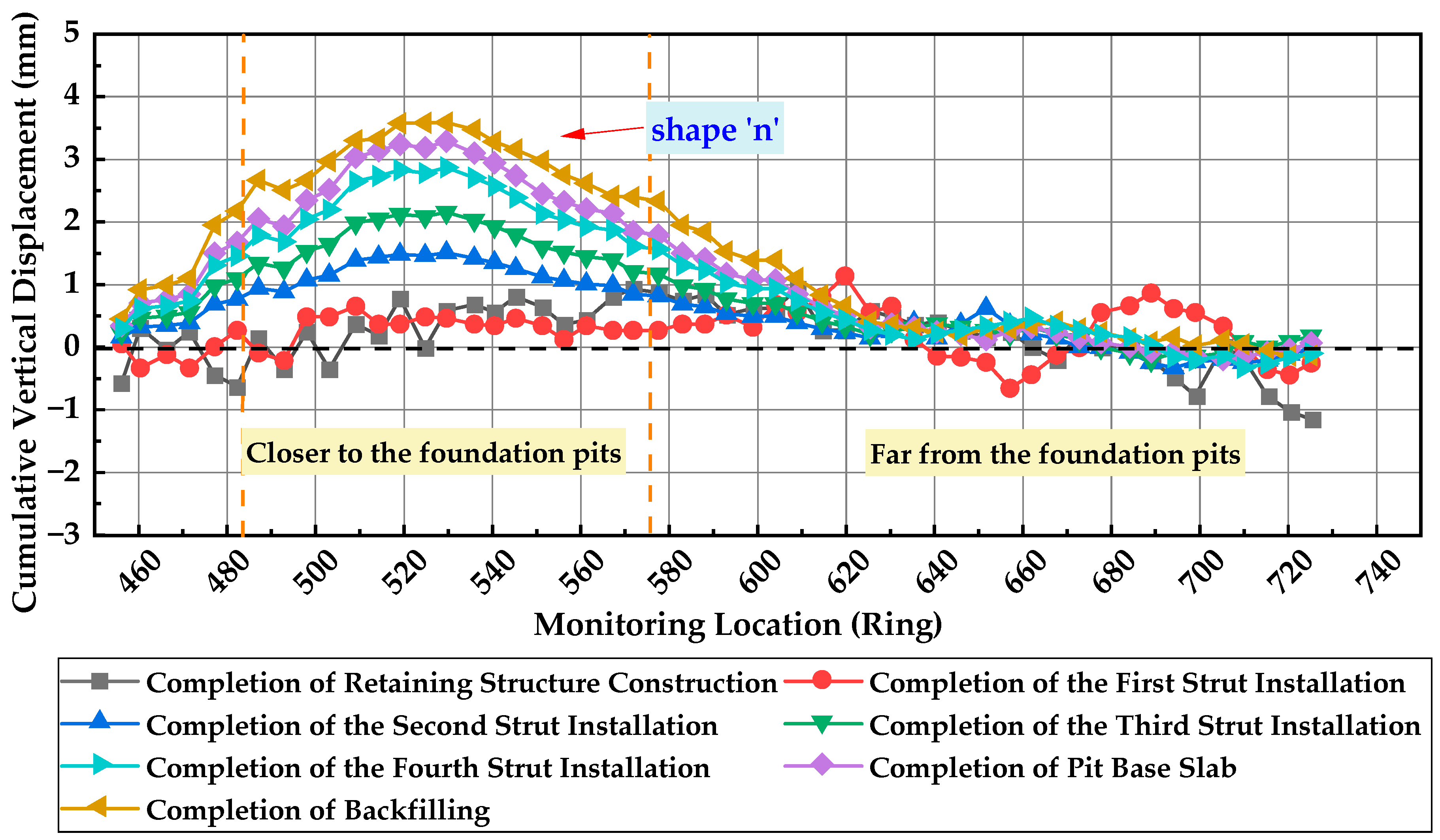
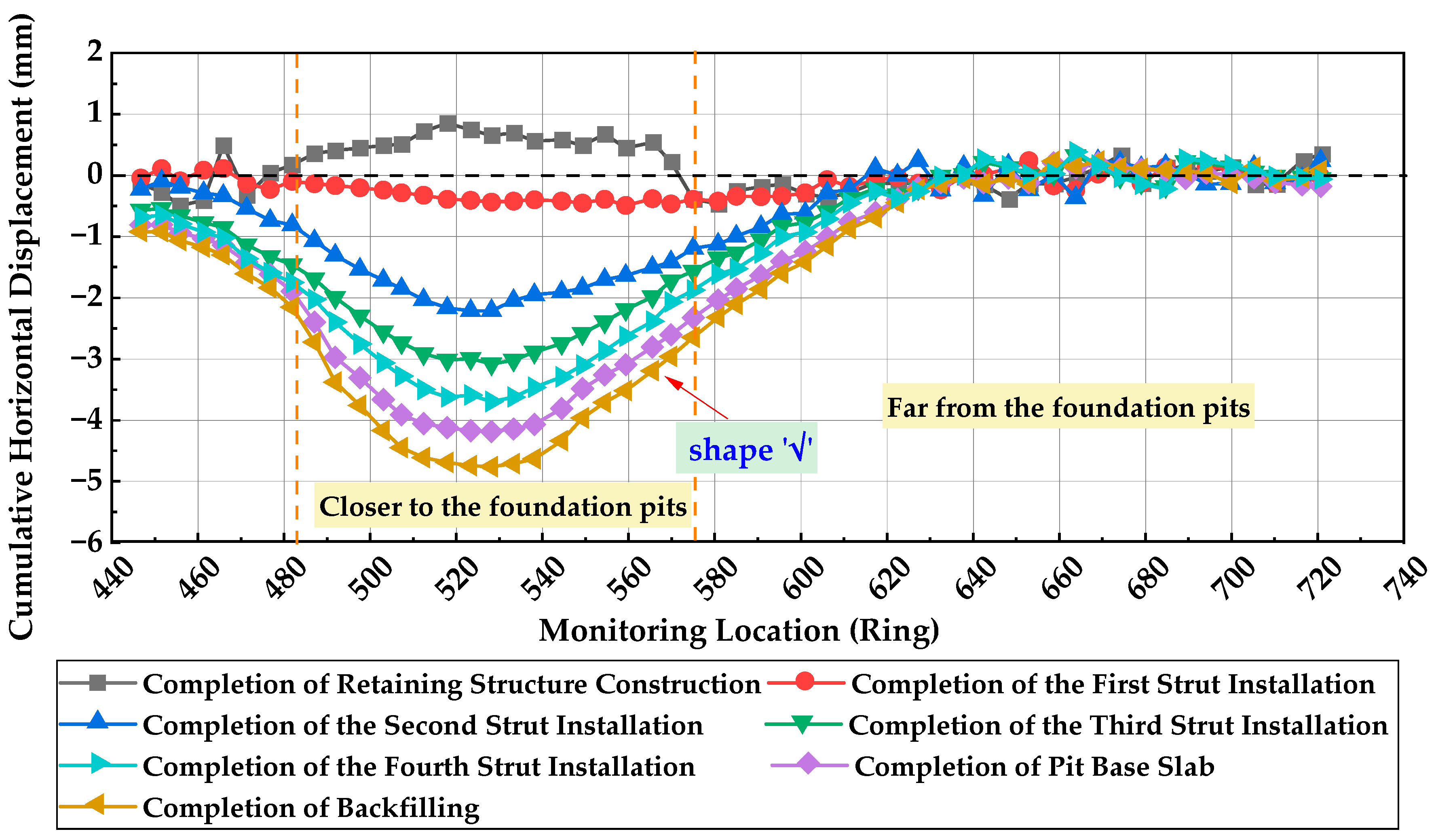
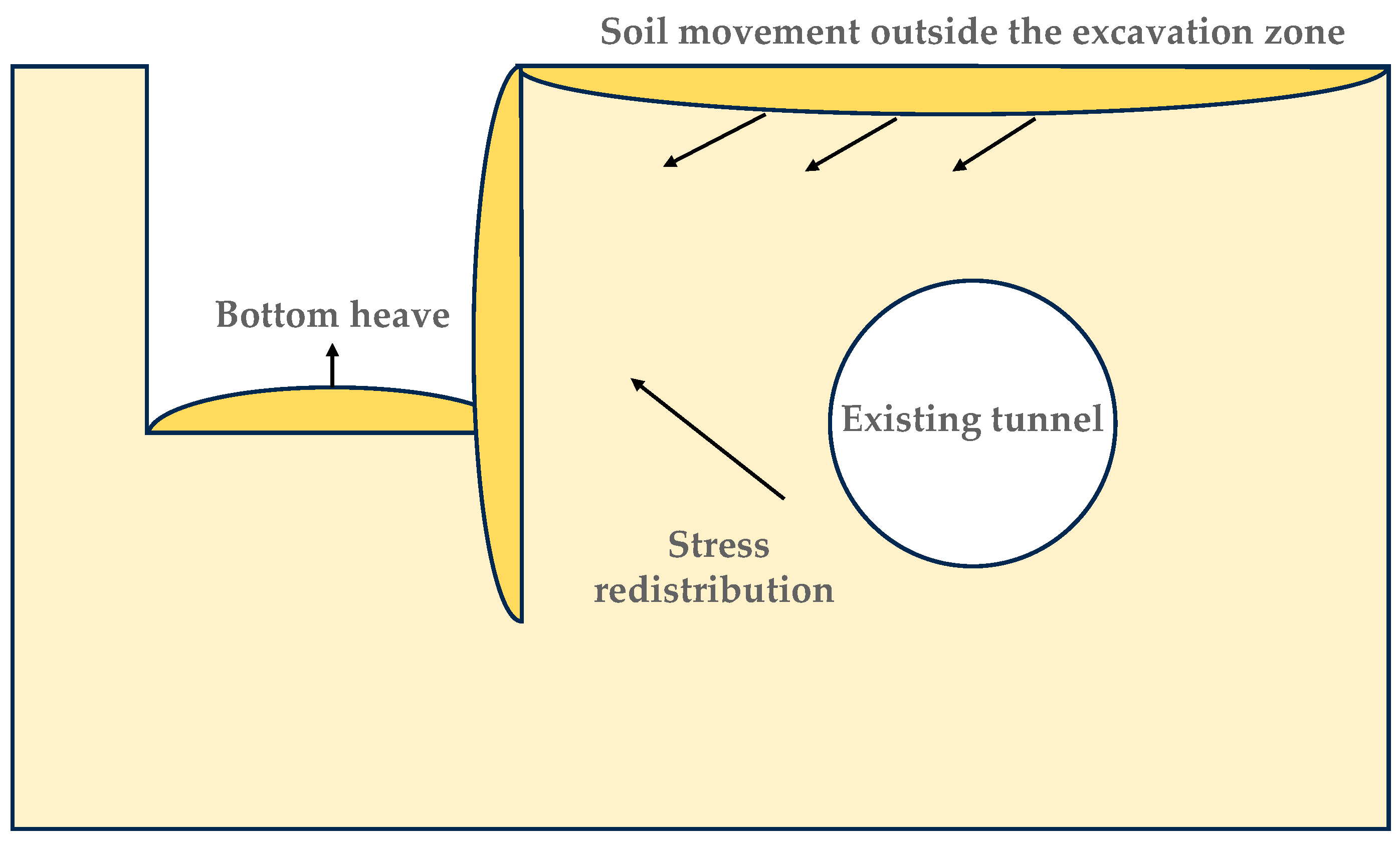

| Properties of the Soil | Unit Weight (kN/m3) | Cohesion (kPa) | Friction Angle (°) | Elastic Modulus (kN/m2) |
|---|---|---|---|---|
| Miscellaneous fill | 19 | 10 | 18 | 5000 |
| Silty clay | 19.2 | 15 | 20 | 4830 |
| Silty clay | 19.3 | 37.5 | 18 | 5630 |
| Silty clay with gravel | 19.6 | 37.5 | 20 | 6270 |
| Completely weathered diorite | 20 | 45 | 20 | 25,000 |
| Structures | Element Type | Elastic Modulus (GPa) | Poisson’s Ratio |
|---|---|---|---|
| Shield segment | Plate | 34.5 | 0.2 |
| Diaphragm wall | Plate | 30 | 0.2 |
| Internal strut | Beam | 30 | 0.2 |
| Ground anchor | Embedded Truss | 210 | 0.3 |
| Monitoring Items | Control Values | ||
|---|---|---|---|
| Accumulated Values | Variation Rate | Alert Thresholds | |
| Horizontal displacement | 5 mm | 1 mm/d | 10 mm |
| Vertical displacement | 5 mm | 1 mm/d | 10 mm |
| Total displacement | 5 mm | 1 mm/d | 10 mm |
| Foundation Pit Project | Excavation Depth (m) | Relative Position to Tunnel | Minimum Clear Distance (m) | Tunnel Deformation (Max. Uplift, mm) | Main Stratigraphic Conditions |
|---|---|---|---|---|---|
| A foundation pit adjacent to Hangzhou metro Station | 16.8 | Tunnel above the side of the pit | 9.3 | −7.8 | Sandy silt |
| Hangzheng storage plots 86-1,2 | 15.8 | Tunnel above the side of the pit | 4.5 | +9.0 | Sandy silt |
| Jianggan district Weidong pit, Hangzhou | 12.55 | Tunnel above the side of the pit | 17.3 | +5.3 | Clayey silt |
| A building foundation pit, Jianggan district, Hangzhou | 5.7 | Tunnel below the side of the pit | 24 | +3.1 | Clayey silt |
| Xiasha economic zone pit, Hangzhou | 11.8 | Tunnel below the side of the pit | 11 | −4.5 | Sandy silt |
| Hangzheng storage plot No. 16 | 10.7 | Tunnel below the side of the pit | 10.5 | −4.4 | Silty clay |
| Shanghai Dongfang Road interchange project | 6.5 | Up/Down Tunnels in Sections No. 1/No. 2 | 2.76 | Up: +11.56, Down: +12.3 | Silty clay |
| Shanghai East-West underground express tunnel (Pudong Section) | 10.2 | 45° diagonally crossing below the pit | 4 | Up: +12.10, Down: +14.20 | Silty clay |
| Nanjing Longpan Road tunnel (South Section) West Pit | 7.9 | 70° diagonally crossing below the pit | Left 2.73, Right 2.15 | Left: +3.20, Right: +5.50 | Silty clay |
| Tianjin West Station underground tunnel | 4.75 | Below existing metro box structure | 0.3 | Cumulative uplift: +8.10 | Silty clay |
Disclaimer/Publisher’s Note: The statements, opinions and data contained in all publications are solely those of the individual author(s) and contributor(s) and not of MDPI and/or the editor(s). MDPI and/or the editor(s) disclaim responsibility for any injury to people or property resulting from any ideas, methods, instructions or products referred to in the content. |
© 2025 by the authors. Licensee MDPI, Basel, Switzerland. This article is an open access article distributed under the terms and conditions of the Creative Commons Attribution (CC BY) license (https://creativecommons.org/licenses/by/4.0/).
Share and Cite
Liu, T.; Liang, Y.; Peng, H.; Yu, L.; Xing, T.; Zhan, Y.; Zheng, J. Deformation Patterns and Control of Existing Tunnels Induced by Coastal Foundation Pit Excavation. J. Mar. Sci. Eng. 2025, 13, 773. https://doi.org/10.3390/jmse13040773
Liu T, Liang Y, Peng H, Yu L, Xing T, Zhan Y, Zheng J. Deformation Patterns and Control of Existing Tunnels Induced by Coastal Foundation Pit Excavation. Journal of Marine Science and Engineering. 2025; 13(4):773. https://doi.org/10.3390/jmse13040773
Chicago/Turabian StyleLiu, Tao, Yunlong Liang, Huadong Peng, Liucheng Yu, Tongju Xing, Yuanzhe Zhan, and Jianguo Zheng. 2025. "Deformation Patterns and Control of Existing Tunnels Induced by Coastal Foundation Pit Excavation" Journal of Marine Science and Engineering 13, no. 4: 773. https://doi.org/10.3390/jmse13040773
APA StyleLiu, T., Liang, Y., Peng, H., Yu, L., Xing, T., Zhan, Y., & Zheng, J. (2025). Deformation Patterns and Control of Existing Tunnels Induced by Coastal Foundation Pit Excavation. Journal of Marine Science and Engineering, 13(4), 773. https://doi.org/10.3390/jmse13040773






